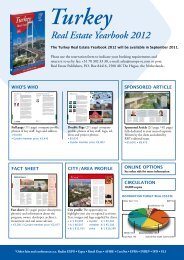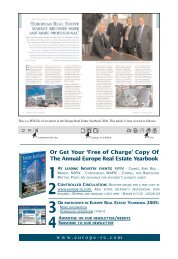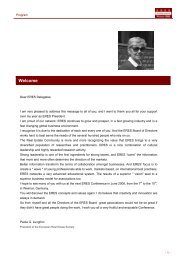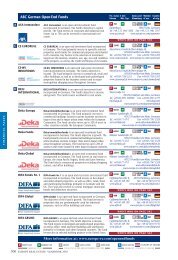Market Report 2011 GerMany - Europe Real Estate
Market Report 2011 GerMany - Europe Real Estate
Market Report 2011 GerMany - Europe Real Estate
You also want an ePaper? Increase the reach of your titles
YUMPU automatically turns print PDFs into web optimized ePapers that Google loves.
6<br />
Leading economic indicators such as the BA-X labour market index issued by the Federal<br />
Employment Agency and the Ifo Institute’s Employment Barometer suggest that<br />
the upturn in the labour market in Germany is likely to continue this year. This is due<br />
not least to the increasing number of service companies seeking to employ new staff.<br />
The most recent forecasts by various economic research institutes – e.g. the Kiel<br />
Institute for the World Economy the RWI – indicate that employment will increase<br />
by over 1% during the current year. As a result, the labour market offers favourable<br />
conditions for an expansion in office employment. This will lead to additional demand<br />
for office space and a recovery in the rental markets in Germany.<br />
Inflation rate currently above the target level of the ECB<br />
The past few months have seen a noticeable acceleration in prices during the course<br />
of the economic recovery. The general cost of living index in Germany in March <strong>2011</strong><br />
was up 2.1% on the previous year’s figure. A central reason for this development are<br />
higher prices for energy and foodstuffs.<br />
Second-round effects of high wage demands or the passing on of higher costs to consumers<br />
cannot be excluded. This applies all the more in Germany given that capacity<br />
utilisation during the course of the vigorous economic recovery has once again<br />
exceeded the long-term average value. Based on the most recent forecasts, Germany<br />
can therefore expect an inflation rate of around 2.5% for the current year.<br />
The <strong>Europe</strong>an Central Bank’s price target of “close to, but just under 2%” was also<br />
exceeded most recently in the Eurozone. Compared with the previous year, inflation<br />
reached 2.4% in February. The <strong>Europe</strong>an Central Bank has expressed its alarm over<br />
the past few months at the higher expected inflation and has already announced an<br />
initial increase of its key interest rate for April.<br />
Most analysts assume that the key interest rate will be increased in a series of steps<br />
from the current rate of 1.0% to 1.75% by the end of the year – even if the downside<br />
risks to the global economy have increased again recently as a result of recent events<br />
in Japan.<br />
First increase of key interest rates by the ECB on the horizon<br />
Against this background and given the favourable economic trends, interest rates on<br />
<strong>Europe</strong>an money and capital markets have increased significantly since September<br />
2010. Most recently, the 3-month Euribor hovered around the 1.2% level, while the<br />
rate for ten-year, fixed-interest German government bonds was roughly 3.3%. In this<br />
context, interest rates trends remain extremely volatile due to the greater sensitivity<br />
of investors, as reflected most recently by the impact of the serious natural catastrophe<br />
in Japan.<br />
Looking ahead to the end of <strong>2011</strong>, a moderate rise of interest rates to 2.0% in the<br />
case of the 3-month Euribor and around 3.5% for ten-year German government bonds<br />
appears plausible against the backdrop of higher inflation expectations and the most<br />
likely economic scenario.<br />
The opportunity and financing costs of property investments are therefore likely<br />
to increase during the coming months.<br />
in %<br />
Inflation rate<br />
3<br />
2<br />
1<br />
0<br />
'0 0 '02 '0 4 '06 '0 8 '10 '1 2e<br />
Source: Bundesbank, forecast by IVG Research<br />
Interest in %<br />
in %<br />
Interest structure curve<br />
4<br />
3<br />
2<br />
1<br />
10-year bonds<br />
6<br />
5<br />
4<br />
3<br />
2<br />
1 2 3 4 5 6 7 8 9 10<br />
Duration in years<br />
Mar 10 Sep 10 Mar 11<br />
Source: Daily press, average interest rate swap<br />
'01 '03 '05 '07 '09 '11<br />
Eurozone UK USA<br />
Source: Oppenheim Research









